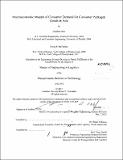| dc.contributor.advisor | Başak Kalkancı. | en_US |
| dc.contributor.author | Mau, Jonathan | en_US |
| dc.contributor.author | McFadden, Bryan P | en_US |
| dc.contributor.other | Massachusetts Institute of Technology. Engineering Systems Division. | en_US |
| dc.coverage.spatial | a------ | en_US |
| dc.date.accessioned | 2013-03-01T15:08:33Z | |
| dc.date.available | 2013-03-01T15:08:33Z | |
| dc.date.copyright | 2012 | en_US |
| dc.date.issued | 2012 | en_US |
| dc.identifier.uri | http://hdl.handle.net/1721.1/77469 | |
| dc.description | Thesis (M. Eng. in Logistics)--Massachusetts Institute of Technology, Engineering Systems Division, 2012. | en_US |
| dc.description | Cataloged from PDF version of thesis. | en_US |
| dc.description | Includes bibliographical references (p. 90-92). | en_US |
| dc.description.abstract | CPGCo, a global manufacturer of consumer packaged goods, has had tremendous difficulty in producing accurate forecasts for its products in developing markets. The problem was especially apparent during the global economic crisis in 2008, which caused demand for its products to become highly volatile. Its troubles have been aggravated by its long forecasting horizon, as it has not been able to adjust quickly enough to rapid market shifts due to fluctuations in various macroeconomic indicators. As a result, CPGCo faces heavy stockouts and excess inventories. This thesis explores the suitability of using macroeconomic indicators to forecast consumer demand for three developing countries in Asia as well as three separate product segments. A total of 27 macroeconomic models are constructed using stepwise multiple linear regression analysis employing three separate dependent variables: the firm's monthly wholesale shipment volume, retail market share by volume, and retail sales. The world oil price and country-specific exchange rates, stock indexes, interest rates, consumer price indexes, and consumer confidence indicators are used as independent variables. With our models, we are capable of producing extremely accurate forecasts for a small sample set with errors at or below 7.2%. Our findings also indicate that the consumer price index has the most influence on consumer demand, appearing in 81% of our models; thus, we recommend that CPGCo tracks the consumer price index of each country to complement its current forecasting processes. | en_US |
| dc.description.statementofresponsibility | by Jonathan Mau and Bryan P. McFadden. | en_US |
| dc.format.extent | 106 p. | en_US |
| dc.language.iso | eng | en_US |
| dc.publisher | Massachusetts Institute of Technology | en_US |
| dc.rights | M.I.T. theses are protected by
copyright. They may be viewed from this source for any purpose, but
reproduction or distribution in any format is prohibited without written
permission. See provided URL for inquiries about permission. | en_US |
| dc.rights.uri | http://dspace.mit.edu/handle/1721.1/7582 | en_US |
| dc.subject | Engineering Systems Division. | en_US |
| dc.title | Macroeconomic models of consumer demand for consumer packaged goods in Asia | en_US |
| dc.type | Thesis | en_US |
| dc.description.degree | M.Eng.in Logistics | en_US |
| dc.contributor.department | Massachusetts Institute of Technology. Engineering Systems Division | |
| dc.identifier.oclc | 827223955 | en_US |
